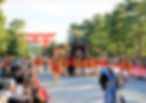Jidai Matsuri - The Festival of the Ages
- April Dykes
- 10月22日
- 読了時間: 4分
Jidai Matsuri, the Festival of the Ages, is one of Kyoto’s 3 major festivals. It is held annually on October 22nd. It is known for its walk through history in the form of processions that showcase the different eras during which Kyoto was the capital of Japan; from 794 to 1868.
Kyoto has many names, but the most common at the time was Heian-kyō, 平安京, which translates to the capital of peace and tranquility. “Since ancient times in East Asia, the 京 (kyo, archaic 亰) Chinese/kanji character indicated that the emperor lived in the city, making it the Imperial capital. That’s why we see kyo (京) in the name of former and current Imperial capitals in Japan and China, including Tokyo (東京)” (Ono, para 2).

The origins of Jidai Matsuri
In 1868, the Emperor relocated from Heian-kyō to Edo, which was subsequently renamed Tokyo, the eastern capital. No longer being the capital came with challenges that Kyoto faced head-on. It maintained its culture through art, architecture, and academics. In 1895, the Heian Jingu Shrine was built to honor Emperor Kanmu, the emperor who made Heian-kyo the capital in 794. It is here that Emperor Kanmu is enshrined, and he is one of the main deities that are worshipped during the festival. The other deity enshrined is Emperor Komei, the last Emperor to rule in Kyoto. The Jidai Matsuri was held the same year to commemorate the 1100th anniversary of Heian-kyō’s founding.

According to Kyoto Shinbun, the first Jidai Matsuri procession was a pilgrimage from the Imperial Palace to Heian Jingu Shrine when it was first built. It later became the procession we know today, for Emperor Kanmu and Emperor Komei, important Heian-kyō figures. “Commemorative shrine festivals were held from October 22nd to 24th, with support from “Heian Kosha”, an organization established by Kyoto citizens in order to manage and preserve the shrine.
The Jidai Matsuri Festival originated from a procession held around the time of these commemorative events, showcasing traditional costumes from different periods of Japanese history. Initially held on October 25th, the day following the shrine festivals, the procession was moved to 22 from 1896 onward – the anniversary date of the capital’s transfer to Kyoto. Heian Jingu Shrine continues to organize the Jidai Matsuri Festival to this day” (Kyoto Travel, para. 6).
The Procession
The procession consists of 8 eras represented through around 2000 participants, who portray the everyday citizens to prominent figures such as Princess Kazunomiya and Oda Nobunaga, as they march from the Imperial Palace to Heian Jingu Shrine.
The 8 eras covered during the procession are:
Meiji Restoration Era (around 1868)
Edo period (1603 – 1868)
Azuchi-Momoyama period (1568 – 1603)
Muromachi period (1338 – 1573)
Yoshino period (1333 – 1392)
Kamakura period (1192 – 1333)
Fujiwara period (897 – 1185)
Enryaku period (782 – 806)
Originally, the Jidai Matsuri only had six processions: the Enryaku Civil Officials’ Attendance at Court, the Enryaku Military Officers’ March, the Fujiwara Court Nobles’ Attendance at Court, the Jōnan Yabusame (horseback archery) Procession, Lord Oda’s Entry into the Capital, and the Tokugawa Castle Envoys’ Entry into the Capital (MK Kyoto). The Restoration Loyalist Corps procession was added in 1921.
In 1932, “the processions of Lord Kusunoki's Kyoto arrival and Lord Toyotomi's visit to the court were added, bringing the total to 10” (Kyoto Shinbun). In 1944, the festival and its procession were suspended due to the war, but it was restored in 1950, and 3 new women's processions were added. Those processions represented the Edo period, the Middle Ages (11th-16th century), and the Heian period (794 to 1185). In 1966, a procession of Meiji Restoration patriots was added.
The festival remained unchanged until 2007, when the Muromachi period procession was added, which gave us the 8 eras we enjoy today. “Adding to the fifteen sections above the Shinsen Kōsha Procession (offerings guild), the Vanguard, the Shinkō Procession, the Shirakawame Flower-Offering Procession, and the Archers’ Corps, Jidai Matsuri now consists of twenty sections in total, with approximately 2,000 participants” (MK Kyoto).

The Shinko line is the most important part of the Jidai Matsuri as it contains the deities. “The main procession centered around two Imperial palanquins. Following the Enryaku Period Procession, there is the "Shinsen Kosha Procession" which offers offerings to the gods, the "Front Procession" which includes gagaku musicians, and the "Shinko Procession." In fact, the processions up to now have been there to accompany this Shinko Procession. The Shinko Procession includes two Imperial Pavilions, carrying the divine spirits of Emperor Kanmu and Emperor Komei, the deities enshrined at Heian Shrine.” (Kyoto City Tourism Association). If you would like a detailed description of every procession, check out the official Kyoto Tourism Association website here.
Viewing the Jidai Matsuri
Given the size of the procession and the number of people participating, the festival takes about 2 and a half hours, as it starts at Kyoto Imperial Palace and heads towards the Heian Jingu Shrine. The schedule is as follows:
Kyoto Imperial Palace (12:00) → Sakaimachi Gomon (12:15) → Karasuma Marutamachi (12:30) → Karasuma Oike (12:50) → Kawaramachi Oike (13:20) → Kawaramachi Sanjo (13:30) → Sanjo Ohashi (13:40) → Sanjo Jingumichi (14:10) → Heian Jingu Shrine (14:30)
Every year, there are designated seating areas spread throughout the route. You can start purchasing tickets in September with prices ranging from ¥4,500 to ¥15,000.

If you enjoy music, beautiful clothing, Japanese history, and would love to watch it come to life, the Jidai Matsuri is something you won’t want to miss.
LINKS
EMBEDDED VIDEO https://www.youtube.com/watch?v=ru06zDcyVL8






